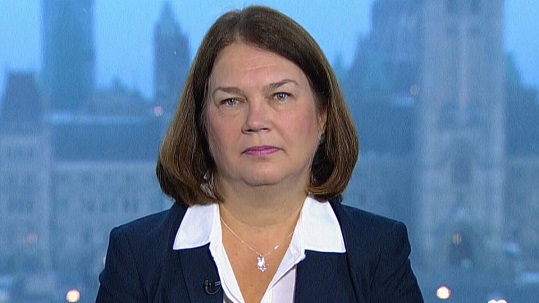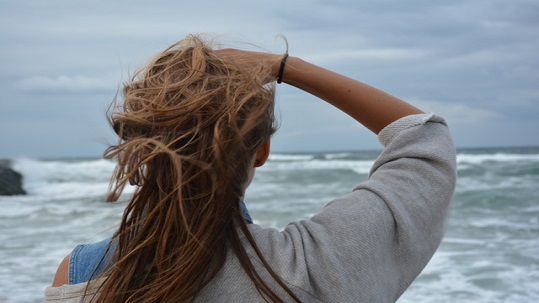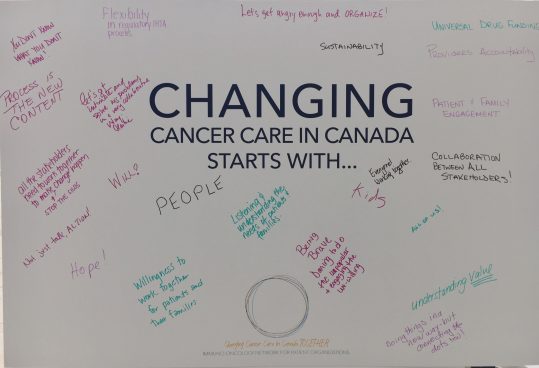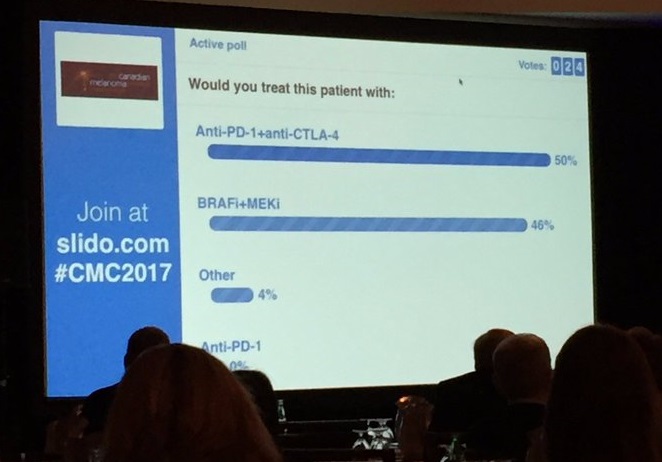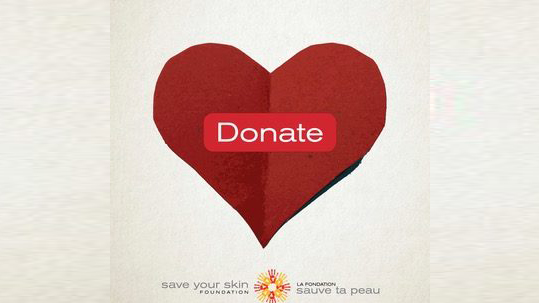My name is Lana Manson. I am forty-nine years old and have been happily married for twenty-six years to a loving, caring man named David. We have four busy and athletic children: Our eldest son, Josh, is twenty-five and a professional hockey player; our next child Meagan is twenty-three and in her 5th year of economics at the University of Saskatchewan (U of S), and has played for the U of S Huskies soccer team for these five years; completing our family are twins, Ben and Emma, who are seventeen and both very active in sports. Emma plays high school soccer and basketball, and will play soccer when she begins attending U of S next year, and Ben is active in hockey. Never have I let my cancer stand in the way of watching their games and events!
I was diagnosed with melanoma in January 2014. The summer of 2013 I nicked a mole on my right calf while shaving. It bled a bit, but I didn’t think anything of it. It never changed colour, shape, or size. Though I wasn’t worried about it, my family and friends thought it would be best to get it checked out. I have always been covered head to toe in freckles and moles, and I had suntanned when I was younger, so I agreed to get a skin examination. The Doctor I went to decided it best to apply liquid nitrogen and burn the mole off. A few weeks afterwards the mole had healed into a weird looking blood blister. I was then referred to a skin specialist who informed me that this was a keloid, or a scar replaced with collagen; not the most attractive looking sore. The Doctor said that I could remove it but it may just grow back larger and worse than it was, so as it was only about the size of a pea I decided to leave it. The doctor finished the examination of my body and said all the other moles looked fine. All in all, I left there feeling like I was in a good place.
A couple months later, around December, the keloid on my leg had began to bleed and emit puss from rubbing on clothing. I decided to go back to the skin specialist and have him check it. Unfortunately, he did not like the way it looked and thought it best to take a biopsy of it; this was December 21st, 2013.
The results got back to us January 7th, 2014. To mine, and my family’s dismay, the Physician informed us it was positive for melanoma and needed to be removed. Within the next week I had met with an Oncologist and a Surgeon and discussed what our plan of attack was going to be. The first step was to have the mole removed. I was booked in for surgery on January 21st, two weeks after finding out the mole was cancerous. While in surgery, they removed the entire area around the mole, as well as a few lymph nodes in my groin to see if the cancer had spread.
After the surgery was done I began the recovery process at home. After a week or two, I was able to walk, so I decided to book a flight to Boston to watch my son play hockey. The day before I was booked to leave, the Oncologist informed me that the cancer had spread to my lymph nodes and I was going to need another procedure to have more removed. I booked the surgery for the day after I got back and went on my trip.
The second surgery was on February 13th, in which they removed most of the lymph nodes in my groin. Following the surgery I had a meeting with the Oncologist again to set the dates of when I would begin my treatment program.
After a CT and a PET scan showing I was all clear, they said I would need to start taking the drug interferon immediately. Afterwards, I was offered the option of radiation, which was 20 four-minute treatments, one per day, which were not painful. So I decided to do the radiation treatment, thinking it could only benefit me. Little did I know, this would end up being the cause for most of my future problems.
Once I started interferon, I had to go to the hospital in Saskatoon Monday through Friday for a month for injections. Every few were in Prince Albert, but for the most part this meant my husband driving just over an hour and back to Saskatoon almost five times a week for all of the month of March. He made the process so much easier for me; I don’t know what I would have done without him. After the first month of intense treatment was done, it then reduced to every three days for eleven months. Fortunately, the needles could be self-injected at home making things easier. However, we were still driving to Saskatoon during the month of April for radiation treatment because it could not be done at the same time as the intense phase of interferon injections.
I responded better than most to the interferon, however, the effects it had on my body were still substantial. I was constantly nauseated, headaches were a common theme, and I had no appetite whatsoever. Not even water tasted good to me anymore. Luckily, the summer months aren’t as busy for my children’s sports because I slept most of the days and was fairly inactive. All of this said, I was on the mend for the summer and thought things were looking up.
Though, as summer wore on, I found my wound was not healing properly. At the end of August 2014, I went back to the Surgeon to get their opinion. The radiation treatment I had opted for had burnt my skin and I needed a debridement. This is where they scrape or cut away all of the dead skin, an extremely painful process. A month later, it still was not healing and I needed to go back for another debridement. Finally, after another month of it not healing I went back to the doctor and they found that the wound was infected. This ended in my last debridement, during which I had to be put under due to the pain. After it was all said and done, the wound that started the size of a quarter had now expanded to a little bigger than a deck of cards. After my third debridement, a negative pressure wound therapy, or vacuum, was put over the wound to help it heal. I then needed to go for a dressing change three times a week at home care. Since my nerve was exposed in my leg, the pain was so considerable that I couldn’t walk. This also made the dressing changes an extremely uncomfortable experience. On top of Tylenol and Gravol, I was now taking morphine and sometimes a shot of Toradol. Suffice it to say, I was a mess.
The vacuum was put on my leg at the beginning of September 2014 and would stay on for ten months. With the interferon injections still ongoing, it made the healing process go extremely slowly. However, I was scheduled to end my interferon treatments in April 2015; woohoo, a shining light at the end of the tunnel! Over the four months following being off the interferon, the wound was now healing more quickly and I watched as it shrank back to the size of a quarter. Though the vacuum was still on, I was already beginning to feel better. My appetite was coming back, there were no more headaches, and I was more active. At the beginning of August 2015, the vacuum was removed from my leg and the wound was now fully closed. I started playing volleyball again, I was exercising, and I was feeling a lot more like my old self!
Everything was going well until my six month checkup at the end of November 2015. My CT results showed two nodules in my lungs that raised some suspicions and a PET scan was scheduled for the beginning of January to get a better idea of what we were dealing with. The results came in and showed the nodules were too small to take a biopsy; we needed to just give them time to see how they react. I was scheduled for another PET scan at the beginning of March and it became a waiting game. I went for the scan in March and the results came back showing the nodules had grown and were more ‘active.’ The diagnosis was that the melanoma had metastasized to my lungs; it was back. They told me that even though you think the cancer has all gone, there is one cell that hides out and finds somewhere else to show up. Mine happened to be in my lungs. With melanoma its not about IF it comes back, but WHERE it comes back. On March 24th, I began receiving the drug Nivolumab, which I was scheduled to take for two years.
On May 16th 2016, I had another CT scan accompanied by a breast biopsy, which showed that the cancer had metastasized to my breasts. We considered removing them but didn’t, as it would not stop the cancer from potentially spreading. It did continue to metastasize; In June 2016, two moles, one on my head and one on my back, came back as cancerous. At this point, my Doctors informed me that I was fighting for my life, as the melanoma was now in my skin and bloodstream. We began looking into clinical trials, though I was adamant that I didn’t want to move away from my kids for a treatment that might not work. I decided to go to Edmonton, a six hour drive away, to undergo the Ipilimumab and Nivolumab combination trial with Drs Michael Smylie and John Walker.
I began the combination drugs on July 27th, and would have to return to Edmonton for four cycles, one every three weeks, for treatment. At the time, fluid was building around my left lung that had to be drained regularly. I had a lung catheter put in and I would drain a litre of fluid every second day. In between my second and third treatment, the fluid build up completely stopped! I went from needing to be drained every second day to no fluids. This was an amazing sign; obviously the drugs were working. There were also no major side effects, only itchy bumps on my torso that were easily treated. The catheter was able to be removed after my fourth treatment cycle on Sept 28th.
On July 18th I had undergone an MRI which confirmed that the cancer had metastasized to my brain. We initially thought there was just one lesion and we would be able to do pinpoint radiation, but there were actually five lesions. After a second MRI done in Calgary on August 2nd, the lesions had reduced in number from five to four. As the drug appeared to be working in my brain, we decided to hold off on full brain radiation until until after the four cycles of treatment. The positive results continued in my next CT and MRI scans on October 6th, which showed that my brain and lung lesions were shrinking, and some had disappeared. Since October 19th I have been on maintenance treatment, which is Nivolumab once every two weeks. I will likely remain on this treatment until my next CT scan at the end of April; hopefully there will be nothing more to treat by then!
How am I feeling now? I feel great, but it is still an emotional roller coaster. They tell you you have cancer and you are sad and scared, then they say it is gone and you are so happy. Then they tell you it’s back and not looking good at all, so you are back to sad and scared. Then a miracle happens and you are going to be okay, so back to happy! Up, down, up, down. Everyday, you think it’s back because you wheezed a bit, or a bump that is itchy, or you have a headache, so you are always worried. Then, you are mad because no one understands this roller coaster and you feel like you are on it alone. Up, down, up, down. But you should not think like that and try to enjoy life. The ride has gotten a lot less bumpy from the start to now.
I was so fortunate to have a very strong support group. My husband, my mom, my close friend, my kids, and other close family and friends. All of them were there to help, talk, cook, drive, or whatever I needed. That meant a lot and it was a very important part of getting well.
It is also very important to believe in yourself. You have to want to fight and beat cancer. It can be done. I knew I had a convocation to go to, two graduations I have to be at, and later grandchildren to spoil! My time is not done. I have a lot of life left to live!
Thank you to my Oncologists, Nurses, Doctors, family, and friends for helping me along the way. Especially my husband and children; I put you through a lot!


